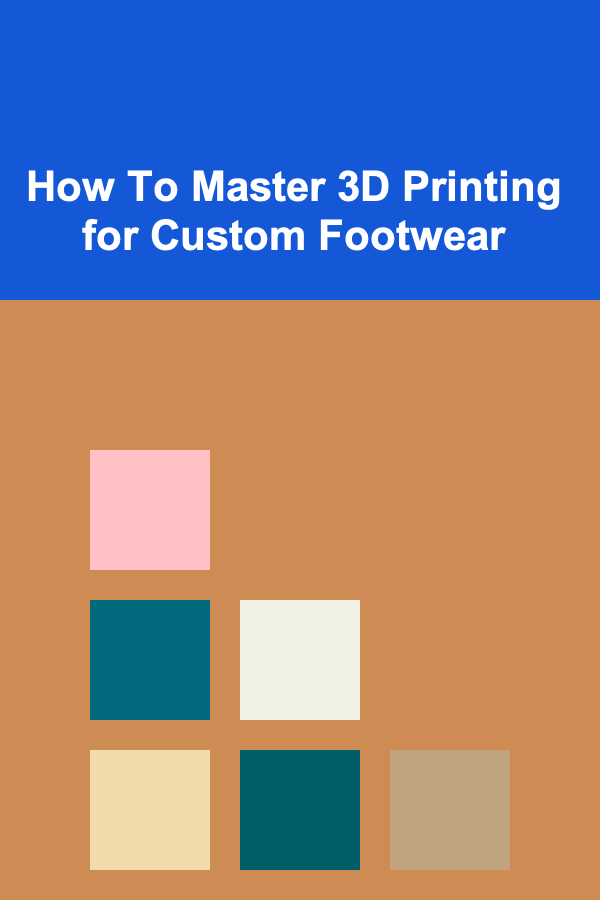
How To Master 3D Printing for Custom Footwear
ebook include PDF & Audio bundle (Micro Guide)
$12.99$10.99
Limited Time Offer! Order within the next:

The rise of 3D printing has transformed industries, from aerospace to healthcare, and now it's revolutionizing the world of fashion. One area that stands to benefit immensely from this innovation is custom footwear. Traditional shoe manufacturing processes have long been limited by mass production methods, where comfort, fit, and design are often sacrificed for efficiency and cost. However, with the advent of 3D printing, footwear design is entering a new era---one where shoes can be uniquely tailored to individual preferences, anatomical needs, and aesthetic desires.
Mastering 3D printing for custom footwear involves understanding the process, the materials, and the technology that make it possible. This article delves into the essentials of 3D printing for footwear, offering insights into how it works, the challenges involved, and how you can master the art of creating custom shoes through 3D printing.
Understanding 3D Printing for Custom Footwear
What is 3D Printing?
3D printing, also known as additive manufacturing, is the process of creating three-dimensional objects by building them layer by layer from digital files. This contrasts with traditional subtractive manufacturing methods, where material is removed from a solid block to create the final product. 3D printing allows for greater design flexibility and the ability to create complex geometries that would be impossible or prohibitively expensive using traditional methods.
3D Printing in Footwear
In the footwear industry, 3D printing enables designers to create custom shoes tailored to the unique needs of the wearer. This customization can be applied to both the aesthetic and functional aspects of footwear. Whether it's adjusting for specific foot shapes, creating intricate patterns, or designing shoes with innovative features, 3D printing offers unprecedented freedom in design.
The process begins with creating a digital 3D model of the shoe, which can be customized in terms of size, shape, and texture. This model is then translated into instructions for the 3D printer, which builds the shoe layer by layer using the chosen material. The result is a fully customized shoe that is both functional and aesthetically pleasing.
Key Benefits of 3D Printing for Custom Footwear
- Personalization: 3D printing allows for highly personalized footwear, taking into account unique foot shapes, medical needs, and style preferences.
- Design Flexibility: Designers can create complex, intricate designs that would be impossible with traditional manufacturing methods.
- Speed: The design-to-production time is significantly reduced compared to traditional methods, allowing for faster prototyping and production.
- Reduced Waste: Since 3D printing is an additive process, it generates less waste compared to traditional manufacturing, which is often wasteful due to material removal.
- Cost-Efficiency for Small Runs: Traditional manufacturing methods require molds and tools that are expensive, particularly for small production runs. With 3D printing, no molds are needed, making it more cost-effective for limited editions or custom designs.
The Technology Behind 3D Printing for Footwear
Types of 3D Printers Used in Footwear
Not all 3D printers are suitable for footwear production, as the material properties and scale needed for shoes require specific types of printers. Here are the main types of 3D printers commonly used in custom footwear production:
- Fused Deposition Modeling (FDM): This is one of the most common types of 3D printers, using a thermoplastic filament that is heated and extruded layer by layer. FDM printers are relatively affordable and accessible, but the material choices for footwear are somewhat limited compared to other technologies.
- Stereolithography (SLA): SLA printers use a laser to cure liquid resin layer by layer, offering high precision and detail. SLA is ideal for creating detailed designs and prototypes but may not be as suitable for producing functional footwear at scale due to limitations in material durability.
- Selective Laser Sintering (SLS): SLS printers use a laser to sinter (fuse) powdered material, such as nylon or other thermoplastics, into solid structures. SLS is widely used in the footwear industry because it can produce durable, lightweight, and flexible parts, making it suitable for producing both the shoe upper and sole.
- Multi-Jet Fusion (MJF): MJF printers use a similar method to SLS but with multiple printheads, allowing for faster production speeds. The material used in MJF is often more durable and can support more complex geometries, making it ideal for footwear that requires both strength and flexibility.
- Digital Light Processing (DLP): DLP technology is similar to SLA but uses a digital light projector instead of a laser to cure resin. DLP is faster than SLA and provides high resolution, making it suitable for small production runs of intricate footwear designs.
Materials Used in 3D Printing Footwear
The materials used in 3D printing footwear must meet specific requirements such as durability, flexibility, comfort, and wear resistance. The most commonly used materials for footwear include:
- Thermoplastic Polyurethane (TPU): TPU is a popular material for footwear due to its flexibility, durability, and abrasion resistance. It is often used for soles and midsoles, providing cushioning and support.
- Nylon: Nylon is known for its strength, flexibility, and lightweight properties. It is commonly used in the production of shoe uppers and midsoles and can be easily customized through 3D printing.
- Photopolymer Resins: These resins are commonly used in SLA and DLP printers to create highly detailed and rigid shoe components, especially for footwear designs that require high precision.
- Rubber: In some cases, rubber-like materials are used for printing footwear to achieve a more traditional feel and comfort. These materials can provide flexibility and cushioning similar to traditional shoe materials.
- Recycled Materials: In an effort to reduce waste and promote sustainability, some companies are exploring the use of recycled materials, such as plastic waste, to create 3D printed shoes.
Designing Custom Footwear for 3D Printing
Step 1: Understanding Foot Anatomy
Before diving into the design process, it's essential to understand foot anatomy. A successful custom footwear design must take into account the unique structure of the wearer's feet, including the arch, toe length, and foot width. A personalized approach can help alleviate issues like foot pain, discomfort, or improper fit, which is often the result of generic shoe designs.
To create a 3D printed shoe that fits perfectly, you must first acquire the necessary data about the foot. This can be done through various methods:
- 3D Scanning: 3D foot scanning technology captures the precise measurements and shape of the foot, allowing for a digital model to be created. This model can then be used as the foundation for the custom shoe design.
- Foot Impressions: Traditional methods like foot impressions (casting the foot in a soft material) can also provide an accurate representation of the foot's shape.
Step 2: Creating the 3D Model
Once you have the data about the foot, the next step is to create a 3D model of the shoe. Software such as Blender, AutoCAD, and Rhino are commonly used for 3D design, offering robust features for modeling footwear. The design process allows you to adjust parameters such as:
- Arch Support: The arch of the shoe must align with the wearer's natural foot structure to provide comfort and prevent injury.
- Cushioning and Insoles: Designing the insole to match the contours of the foot can improve comfort and reduce pressure points.
- Aesthetic Design: 3D printing offers flexibility in creating intricate designs, whether you want a sleek, minimalist style or a bold, artistic pattern.
Step 3: Testing and Prototyping
Before moving to full-scale production, it's essential to prototype the shoe. 3D printing is ideal for rapid prototyping because it allows for quick iteration and testing. With 3D printing, you can test different materials, adjust the design, and make modifications to improve the fit, comfort, and performance of the shoe.
Prototyping also allows you to assess the aesthetics of the shoe, making sure that it matches the original design intent. During this phase, it's essential to focus on both the visual and functional aspects of the footwear, ensuring that the final product meets the needs of the customer.
Step 4: Finalizing the Design for Production
Once the prototype has been tested and refined, you can finalize the design for production. The key here is scalability and material selection. Depending on the type of 3D printer and materials used, the production process for custom shoes can vary. However, with the right materials and printer, 3D printing can be used for both one-off custom designs and small-batch production.
Step 5: Post-Processing and Finishing
After the shoe has been printed, post-processing is often required to finish the product. This can include removing excess material, smoothing rough edges, and adding surface treatments to improve the durability or appearance of the shoe. For example, the printed shoe might be coated with a rubberized material to enhance its durability and comfort.
Challenges and Considerations in 3D Printed Footwear
While 3D printing offers many benefits, there are also challenges to be aware of:
- Material Limitations: Not all 3D printing materials are suitable for footwear, and some may lack the durability or comfort needed for long-term wear.
- Quality Control: Ensuring that each shoe is of high quality and meets the required standards can be difficult, especially in large-scale production.
- Cost: While 3D printing can be cost-effective for small runs and prototypes, the price of advanced 3D printers and materials can be high.
- Comfort and Fit: Ensuring the shoe is not only aesthetically pleasing but also functional and comfortable for everyday wear is crucial.
Conclusion
Mastering 3D printing for custom footwear requires a deep understanding of the technology, materials, and design processes involved. From the initial scan of the foot to the final printed shoe, each step in the process offers an opportunity for innovation and creativity. As 3D printing technology continues to evolve, the future of custom footwear is limitless, offering more personalized, sustainable, and functional shoes than ever before. Whether you're a designer, manufacturer, or simply an enthusiast, learning the intricacies of 3D printing for footwear can open up exciting possibilities for the future of fashion.

10 Effective Tips for Cutting Down on Restaurant and Coffee Shop Expenses
Read More
Becoming a Successful Electrical Engineer: Best Practices for Career Growth
Read More
How to Organize Your Closet for Special Events
Read More
How to Set Up an Art Station with Organized Supplies
Read More
How To Apply Virtue Ethics to Character Development
Read More
How to Create a Baking Planner for Holiday Gifts
Read MoreOther Products

10 Effective Tips for Cutting Down on Restaurant and Coffee Shop Expenses
Read More
Becoming a Successful Electrical Engineer: Best Practices for Career Growth
Read More
How to Organize Your Closet for Special Events
Read More
How to Set Up an Art Station with Organized Supplies
Read More
How To Apply Virtue Ethics to Character Development
Read More